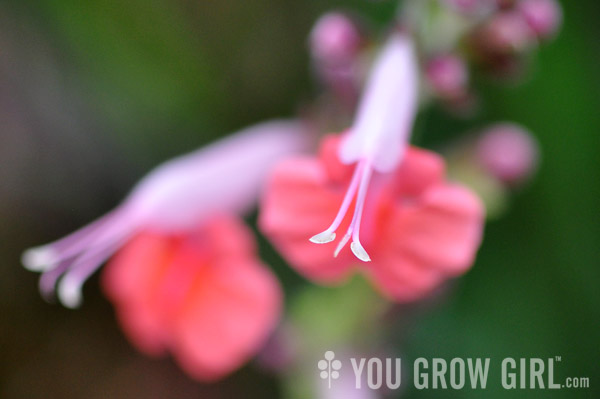
I like salvias. I like any and all salvias; from the delicious, culinary sages to the nectar-rich, super smellerific and sticky sweet types that aren’t hardy in my region. I even like the ones that aren’t edible or aromatic. I’m not sure what it is about this genus. Is it their drought tolerance? Their snapdragon-like flowers? Their textured leaves? Whatever the attraction, I’m on a mission to grow them all, an impossible task given that there are nearly 1000 known species and my growing space can only accommodate a few plants each year.
Still, it’s good to have goals no matter how unattainable.
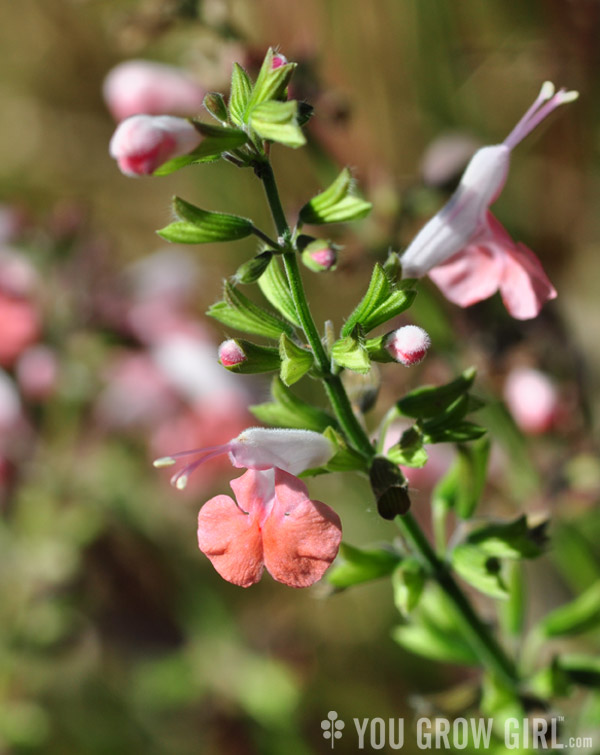
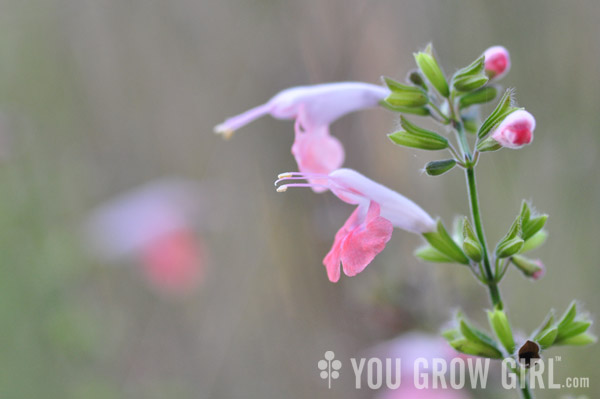
Last year I grew two types that I had never grown before: ‘Black and Blue’ salvia and Salvia coccinea ‘Coral Nymph.’
The latter was sold to me as a compact 1 1/2 ft-tall plant that can withstand a short life in a medium-sized pot. I started mine from seed that I bought from Renee’s Garden. I germinated a few underneath lights about 6 weeks before the last frost and transplanted two seedlings into a 10-12″ wide pot once all possibility of frost had passed. Last year we had a cold, wet spring so I held back until mid-June.
By late summer it produced loads of small flowers on long spikes. They were two-toned light apricot, almost white with a salmon lip. Bees and other pollinators were drawn to their sweet nectar. I have read that they attract hummingbirds too, but try as I might they just haven’t found my city yard.
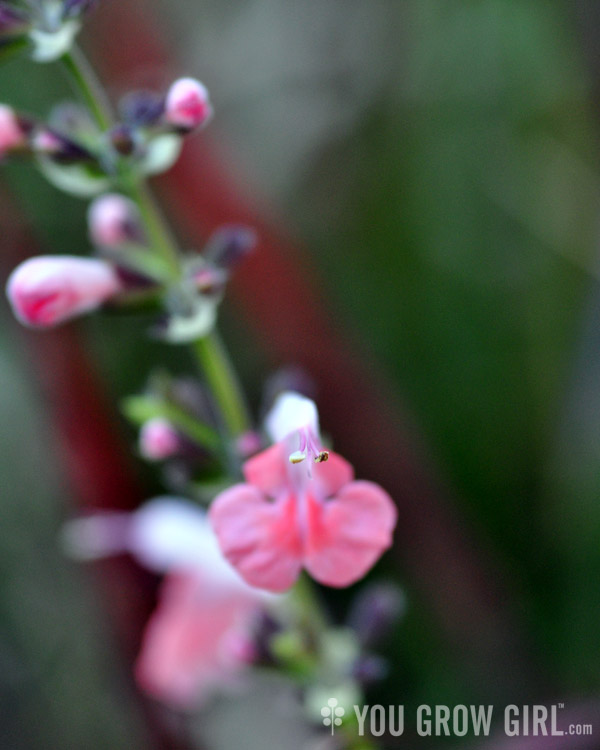
This was not my favourite salvia for scent — there are many others that I’d recommend if this is what you desire. On the plus side, deadheading encouraged a continuous succession of beautiful, little blooms that danced and swayed in the breeze. I was able to move the pot around the garden throughout the season into any spot that needed a boost of colour.
Eventually I allowed the plant to go to seed. I didn’t collect and save, but instead let them fall onto the soil around the pot. It remains to be seen whether they will germinate this spring. I’ve read that the plant is a reliable self-seeder, but after this cold and wet winter I’m not particularly optimistic.
I’m sorry I don’t have a photo of the full container. I searched through all of the photos I took last summer and couldn’t find the images I was sure I had taken.
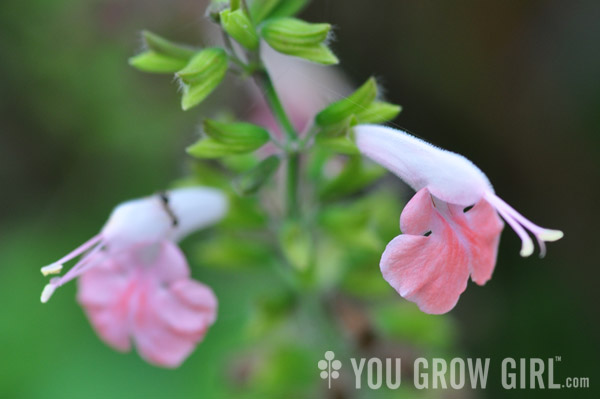
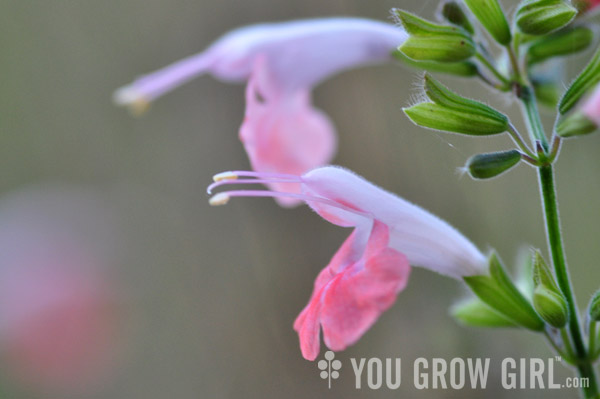
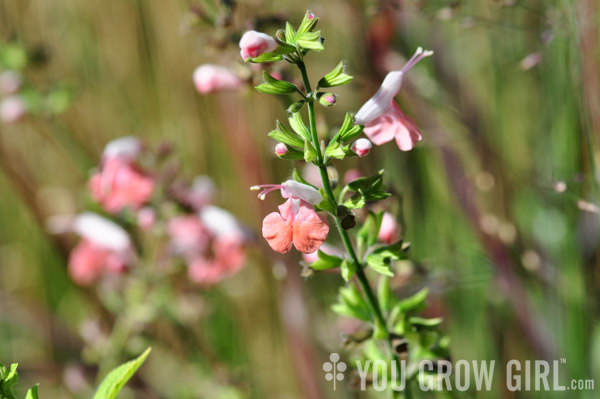
The Details
- Climate: Zones 7-11. Definitely not my zone, which means it must be grown as an annual.
- Conditions: Like all salvias it likes it warm and bright with well-draining soil that does not become waterlogged. Grow it in ful sun or part shade depending on your climate.
- Container Growing: I grew 2 plants in a 10″ wide pot. This may be your best option if your in-ground soil is not well-draining. Container soil should be gritty. I use a mix prepared for cactus and succulents.
- Blooms summer to fall. I found that as an annual in a colder climate, the bloom time was more like late summer.
I grew Coral Nymph Salvia one summer from seed with lovely results. I did not deadhead or save seeds. The next year I found quite a few seedlings nearby. The 2nd year I saved seeds and grew more inside early for the next summer- good results again. I have not deliberately started these seeds for several seasons now and each summer I see a few seedlings popping up. I did observe a hummingbird come to the Coral Nymphs as they were fortuitously located near the red flowering Cypress Vine (Ipomoea) which is a hummer favorite. Your photos are a gorgeous shade of coral.
Setting goals is always admirable! 1000 Sages, wow!
In a similar sage-y category, I have bushy Pineapple Sage plants grown from overwintered cuttings, luxuriating under grow lights, recently split from a pot with 3 crowded plants to 3 individual pots. All sages I’ve grown are interesting garden plants.
One of the showiest is the ‘Marble Arch’ series (annual). I missed it and decided to grow some seedlings this year. They sprout reliably in propagation trays and are puffing up nicely as we speak. I’m trying to time their bloom to coincide with the local garden club tour which includes me this year! So much work ahead.
I love the Marble Arch salvia and wish I had more space to dedicate to them. I like the way it looks when there are lots.
I have (had??) three of these in my garden and they bloomed prolifically for me two years in a row, coming back from the roots last winter and heartily seeding themselves everywhere in the garden. I’m still waiting on them to return this spring though, since we had an incredibly rough winter here in SE Texas, including a late freeze with ice that knocked back a lot of plants that were attempting to emerge after two weeks of warm weather. I’ve not given up hope yet, but if they aren’t up by May I’m guessing they are goners and I can only hope some seedlings will decide to sprout instead.
I love salvias and we propagate many varieties at our local botanic garden. They are absolute hummingbird magnets. Of course I have the luxury of being in Southern California so they are always happy and green and their bloom season is long. For fall I am hugely fond of elegans (pineapple sage) as the bright red blooms in contrast to the big soft leaves are a cool weather treat. I use the leaves for herbal tea. I planted a gregii variety interspersed with feathery lavender in front of an office building and the combo has been delighting with blooms for many many months (never seemed to stop in our non-winter) Plants that pollinators love – how can you go wrong?
Hi,
I really enjoy your web site, and have a question that I’d like you to help me with.
Several years ago I planted Blue Flax and they re-seeded the next year, but years to follow I bought seed packets and tried them without any results. Have any suggestions?
Harris